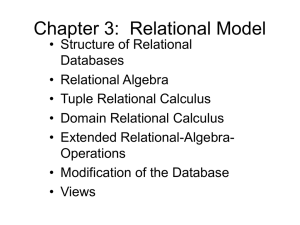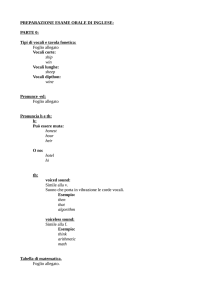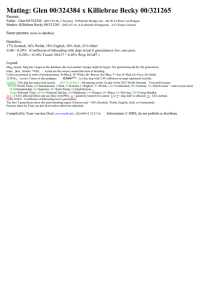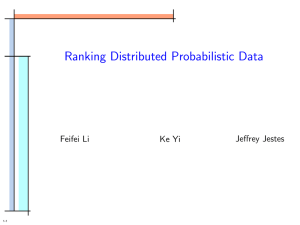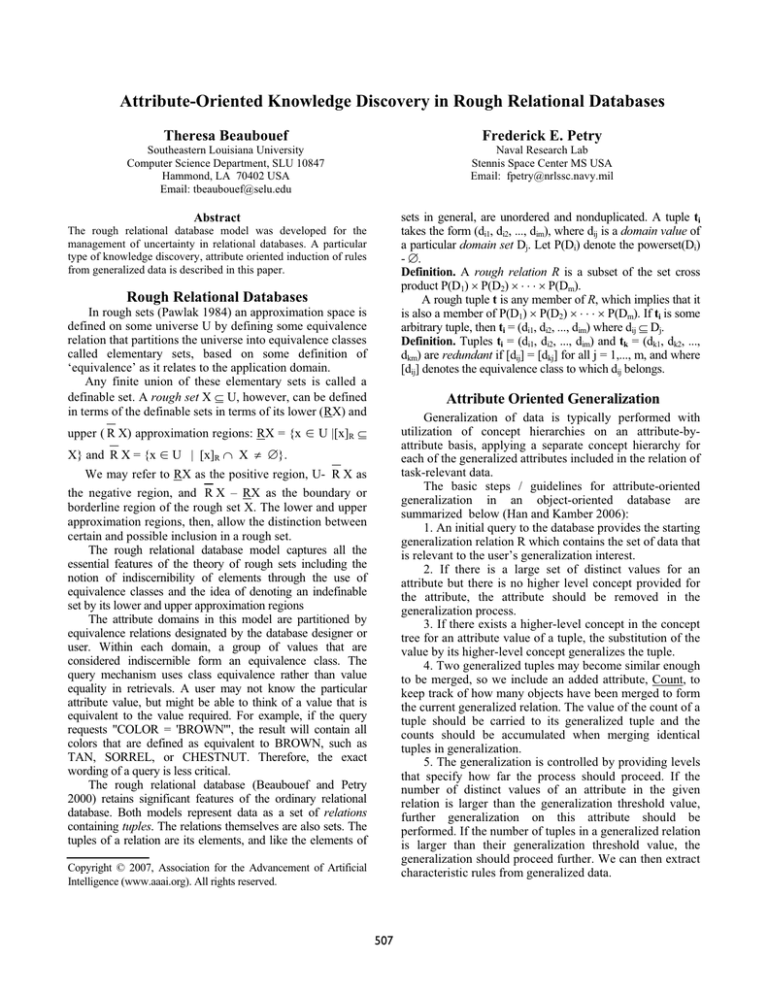
Attribute-Oriented Knowledge Discovery in Rough Relational Databases
Theresa Beaubouef
Frederick E. Petry
Southeastern Louisiana University
Computer Science Department, SLU 10847
Hammond, LA 70402 USA
Email: tbeaubouef@selu.edu
Naval Research Lab
Stennis Space Center MS USA
Email: fpetry@nrlssc.navy.mil
sets in general, are unordered and nonduplicated. A tuple ti
takes the form (di1, di2, ..., dim), where dij is a domain value of
a particular domain set Dj. Let P(Di) denote the powerset(Di)
- .
Definition. A rough relation R is a subset of the set cross
product P(D1) u P(D2) u u P(Dm).
A rough tuple t is any member of R, which implies that it
is also a member of P(D1) u P(D2) u u P(Dm). If ti is some
arbitrary tuple, then ti = (di1, di2, ..., dim) where dij Dj.
Definition. Tuples ti = (di1, di2, ..., dim) and tk = (dk1, dk2, ...,
dkm) are redundant if [dij] = [dkj] for all j = 1,..., m, and where
[dij] denotes the equivalence class to which dij belongs.
Abstract
The rough relational database model was developed for the
management of uncertainty in relational databases. A particular
type of knowledge discovery, attribute oriented induction of rules
from generalized data is described in this paper.
Rough Relational Databases
In rough sets (Pawlak 1984) an approximation space is
defined on some universe U by defining some equivalence
relation that partitions the universe into equivalence classes
called elementary sets, based on some definition of
‘equivalence’ as it relates to the application domain.
Any finite union of these elementary sets is called a
definable set. A rough set X U, however, can be defined
in terms of the definable sets in terms of its lower (RX) and
Attribute Oriented Generalization
Generalization of data is typically performed with
utilization of concept hierarchies on an attribute-byattribute basis, applying a separate concept hierarchy for
each of the generalized attributes included in the relation of
task-relevant data.
The basic steps / guidelines for attribute-oriented
generalization in an object-oriented database are
summarized below (Han and Kamber 2006):
1. An initial query to the database provides the starting
generalization relation R which contains the set of data that
is relevant to the user’s generalization interest.
2. If there is a large set of distinct values for an
attribute but there is no higher level concept provided for
the attribute, the attribute should be removed in the
generalization process.
3. If there exists a higher-level concept in the concept
tree for an attribute value of a tuple, the substitution of the
value by its higher-level concept generalizes the tuple.
4. Two generalized tuples may become similar enough
to be merged, so we include an added attribute, Count, to
keep track of how many objects have been merged to form
the current generalized relation. The value of the count of a
tuple should be carried to its generalized tuple and the
counts should be accumulated when merging identical
tuples in generalization.
5. The generalization is controlled by providing levels
that specify how far the process should proceed. If the
number of distinct values of an attribute in the given
relation is larger than the generalization threshold value,
further generalization on this attribute should be
performed. If the number of tuples in a generalized relation
is larger than their generalization threshold value, the
generalization should proceed further. We can then extract
characteristic rules from generalized data.
upper ( R X) approximation regions: RX = {x Ӈ U |[x]R
X} and R X = {x Ӈ U | [x]R X z }.
We may refer to RX as the positive region, U- R X as
the negative region, and R X – RX as the boundary or
borderline region of the rough set X. The lower and upper
approximation regions, then, allow the distinction between
certain and possible inclusion in a rough set.
The rough relational database model captures all the
essential features of the theory of rough sets including the
notion of indiscernibility of elements through the use of
equivalence classes and the idea of denoting an indefinable
set by its lower and upper approximation regions
The attribute domains in this model are partitioned by
equivalence relations designated by the database designer or
user. Within each domain, a group of values that are
considered indiscernible form an equivalence class. The
query mechanism uses class equivalence rather than value
equality in retrievals. A user may not know the particular
attribute value, but might be able to think of a value that is
equivalent to the value required. For example, if the query
requests "COLOR = 'BROWN'", the result will contain all
colors that are defined as equivalent to BROWN, such as
TAN, SORREL, or CHESTNUT. Therefore, the exact
wording of a query is less critical.
The rough relational database (Beaubouef and Petry
2000) retains significant features of the ordinary relational
database. Both models represent data as a set of relations
containing tuples. The relations themselves are also sets. The
tuples of a relation are its elements, and like the elements of
Copyright © 2007, Association for the Advancement of Artificial
Intelligence (www.aaai.org). All rights reserved.
507
Our example is based on a herd management database
for a large ranch housing various types and breeds of
livestock. Some attributes have been partitioned into
equivalence classes as shown. Tuples of a boundary region
of a rough relation are shown in italics if there are any.
COLOR = {[BROWN, TAN, SORREL, CHESTNUT],
[GRAY, GREY], [WHITE, BEIGE], [BLACK]}
BREED = {[BEEFMASTER, BM], [ANGUS, BLACK
ANGUS], …}
The first step in the knowledge discovery process is to
gather together in one rough relation that data that is
relevant for the task at hand.
Tag Breed
CateColor
Problem/
gory
Note
COW
BLACK
NONE
002
003
004
005
006
007
008
{ANGUS,
JERSEY}
ANGUS
{ANGUS, BM}
{ANGUS, BM}
BEEFMASTER
ANGUS
JERSEY
HOLSTEIN
COW
CALF
CALF
COW
BULL
STEER
COW
009
020
CHAROLAIS
BOER
COW
KID
BLACK
BLACK
BLACK
TAN
BLACK
BROWN
{BLACK,
WHITE}
BEIGE
WHITE
021
022
…
BOER
NUBIAN
KID
NANNY
BROWN
GRAY
NONE
GETS_OUT
ESCAPES
HORNED
DANGER
STERILE
{STERILE,
HORNED}
HORNED
{HORNED,
GETS_OUT}
ESCAPES
HORNED
001
duplicates are eliminated when merging redundant tuples, a
count of the number of tuples merged is retained.
The tuples in the generalized relation are formulated
into characteristic rules, assertions characterized by a
majority of the data in the target class of the database, that
data upon which the generalization was based. Quantitative
information is also important as probabilities can be
ascribed based on counts of tuples resulting from each
generalization.
Color
Problem/
Breed CateCount
gory
Note
{BEEF,
DAIRY}
BEEF
BEEF
BEEF
BEEF
DAIRY
DAIRY
COW
BLACK
NONE
1
COW
CALF
COW
BULL
STEER
COW
COW
KID
KID
MEAT
KID
WHITE
DAIRY
NANNY
GRAY
NONE
GETS_OUT
HORNED
DANGER
STERILE
{STERILE,
HORNED}
HORNED
{HORNED,
GETS_OUT}
ESCAPES
{HORNED,
STERILE}
HORNED
1
2
1
1
1
1
BEEF
MEAT
MEAT
BLACK
BLACK
TAN
BLACK
BROWN
{BLACK,
WHITE}
BEIGE
WHITE
BROWN
1
1
1
1
1
Figure 2. Final Stage of Rough Relation Generalization
The generalized relation that results represents some
assertion of facts about the database. Within a tuple, the
conjunction of attribute/value meaning is taken, and
disjunction connects all the rules. Since we normally do
not desire too many disjunctions, we generalize only to a
threshold value, such as some minimal number of resultant
tuples. For our example, the following non trivial rules are
discovered: Beef calves escape, and It is possible that
white kid goats are horned. From this simplified example
we can see how generalization and rule formation occur.
We plan to investigate extensions to this approach by
including fuzzy set uncertainty in the data as well.
Additionally considerations of overlapping categories in a
hierarchy will be studied.
Figure 1. Relevant Relation of Herd Management Database
In the rough relational database, the generalization
process is performed separately on both the “certain”
tuples found in the lower approximation of the rough
relation and the “possible” tuples found in the boundary
region of the upper approximation of the rough relation.
When the process is completed, rules can be ascertained
with probabilities, keeping in mind that generalization
involving the original uncertain tuples will result in rules
that may or may not accurately represent truth—they are
possible. However, they are useful in that they might
provide insight for a domain expert, guiding further
experimentation.
We will use concept hierarchy based on purpose of the
attribute breed:
{meat-animal, dairy-animal} ԯ livestock
{dairy-goat, dairy-cattle} ԯ dairy-animal
{beef-cattle, meat-goat} ԯ meat-animal
{beefmaster, angus, charolais} ԯ beef-cattle
{ jersey, Holstein} ԯ dairy-cattle
{Boer, African } ԯ meat-goat
{Nubian, Saanen, Toggenburg } ԯ dairy-goat
{ Angora, Cashmere } ԯ wool-goat…
We start with data at lower levels of the concept hierarchy.
For every tuple, replace that attribute value with the
concept that generalizes it (its immediate parent) and
accumulate counts for generalized tuples so that when
Acknowledgment
The authors would like to thank the Naval Research
Laboratory’s Base Program, Program Element No.
0602435N for sponsoring this research.
References
Beaubouef, T. and Petry, F. 2000. Fuzzy Rough Set
Techniques for Uncertainty Processing in a Relational
Database. International Journal of Intelligent Systems, vol.
15, Issue 5, pp. 389-424, April, 2000.
Han J. and Kamber M. 2006. Data Mining: Concepts and
Techniques. 2nd ed San Diego, CA Morgan Kaufmann.
Pawlak, Z. 1984. Rough Sets. Int. Journal of Man-Machine
Studies, vol. 21, 1984, pp. 127-134.
508

